The Pantheon, or the Temple of All Gods, is the pinnacle of ancient Roman architecture. Much of it was and remains unique. Firstly, a huge, amazing imagination, inner space. Secondly, the completeness of the architectural composition, innovative construction technologies and a deep semantic component. And finally, an amazing longevity: a pagan sanctuary dedicated to the ancient Roman gods has survived to our time in magnificent condition. Moreover, today it is not just a museum in which history is “conserved”, but a functioning Christian church dedicated to the Virgin Mary, a miracle of ancient architecture, one of the most popular tourist attractions in Rome. This church is also called Santa Maria della Rotonda, due to the round shape of the building. The square on which the Roman Pantheon stands is also called the Piazza della Rotonda. Let’s take a closer look at this amazing temple.
Article content:
Pantheon: an architectural wonder
Ancient history of the Roman Pantheon: 2 fires and 4 emperors
What was the Pantheon in the days of Ancient Rome
Pantheon inside
Dome of the Pantheon
Oculus, or Eye of the Pantheon
How the pagan Pantheon became a Christian temple
Interesting facts about the Pantheon
What to see near the Pantheon
Practical tourist information
Pantheon on the map
Pantheon: an architectural wonder
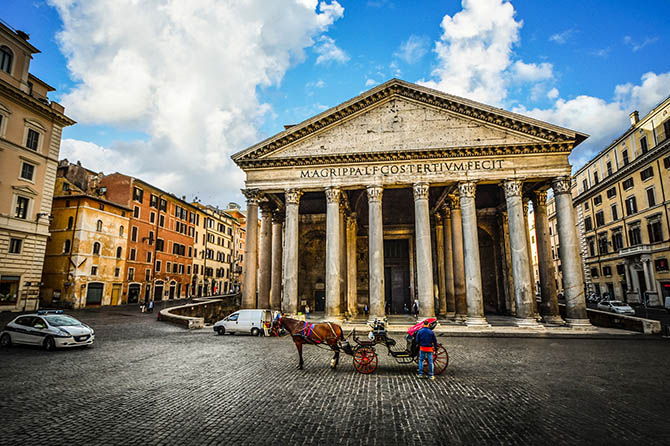
At all times, the Roman Pantheon was perceived as a miracle. For the Romans, who lived in the second decade of the 2nd century, he did not just personify a connection with the starry sky. The Pantheon was the last word in technological innovation. As today we are amazed by spaceships or digital innovations, so this temple admired, amazed, and, most importantly, personified and glorified the greatness of Rome. This was the “golden age” of the Roman Empire, when it ruled over vast territories of Europe and the Mediterranean.
Renaissance geniuses admired the ancient temple. Raphael Santi bequeathed to bury himself within its walls (which was later done). And Michelangelo said that the Pantheon was created by angels, not people.
The same – wonderful, ageless and phenomenal – the Pantheon has survived to this day. This is the only structure of Ancient Rome that has survived in its original state. And today the Roman Pantheon is called the Eighth Wonder of the Ancient World.
History of the Roman Pantheon: 2 fires and 4 emperors
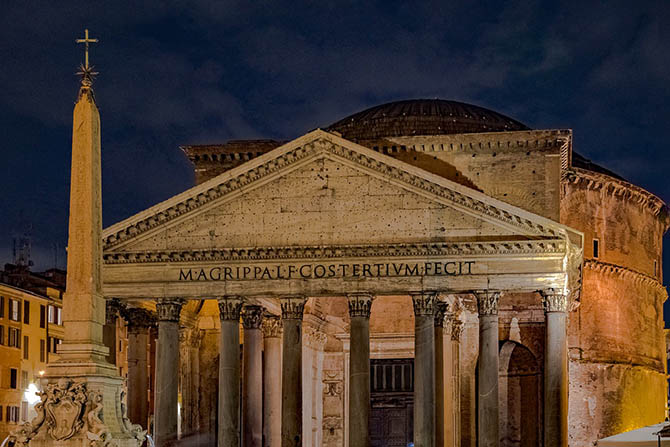
Originally, the Pantheon was erected in honor of the victory of the Roman fleet in the naval battle over Antony and Cleopatra at the Battle of Cape Aktius (now the territory of Greece). The ships of Octavian Augustus were commanded by Marcus Agrippa, his son-in-law and right hand. This victory largely predetermined the creation of the Roman Empire, and soon Octavian Augustus would become the first emperor of Rome.
The construction of the first Pantheon was supervised by the same Mark Agrippa, an outstanding commander and a brilliant organizer. It was back in 27 BC. According to legend, the temple was erected on the spot where Romulus, one of the founders of Rome, ascended to heaven. By the way, contrary to the name, the temple was dedicated not to all, but presumably to seven gods, whose names were given to the planets of the solar system: Jupiter, Venus, Neptune, Mars, Mercury, Pluto and Saturn.
The Pantheon stood for a little over a century, until it burned down in a fire in the 80s. Emperor Domitian restored it, while glorifying the first builder of the temple. The inscription on the frieze of the portico: “ Marcus Agrippa, son of Lucius, thrice consul, did this .” She emphasizes the state status of the Pantheon, which will be erected and will remain for centuries no matter what.
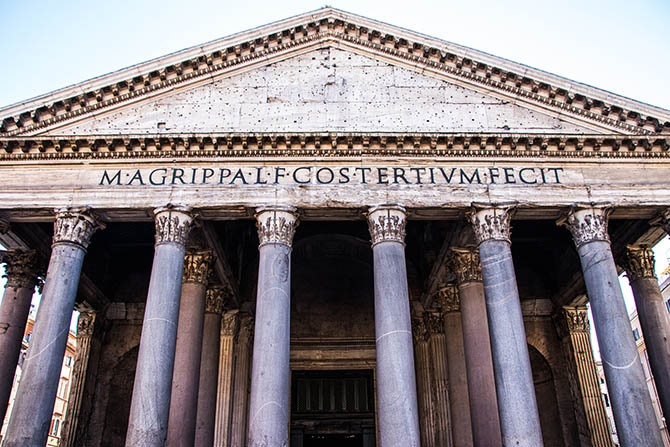
After 30 years, Pantheon-2 will be struck by lightning and again perish in the fire.
According to recent studies, the restoration of the Pantheon after that catastrophe was taken up by Emperor Trajan. It was under him that construction work began, and they were completed in 126 by the emperor Hadrian. He was an active connoisseur of architecture: during his reign, Rome flourished, many new buildings appeared. It is no coincidence that Adrian was called the Restorer.
Like all enlightened Romans, he admired Greek architecture, and the famous Greek sculptor Apollodorus of Damascus was invited to work on the construction of the Pantheon. However, their relationship did not work out, and subsequently the emperor ordered his execution.
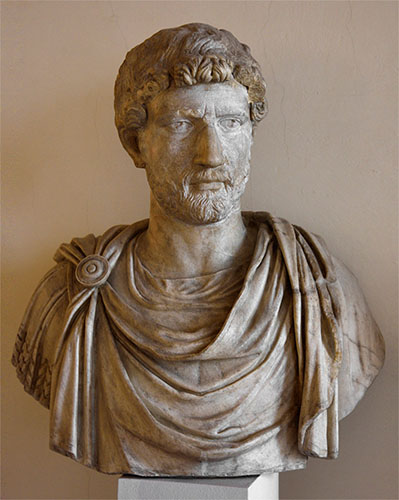
Emperor Hadrian
Read also:
Rome – a guide to world history
What was the Pantheon in the days of Ancient Rome
In comparison with the present century, the cultural layer of Ancient Rome during the construction of the Pantheon was several meters lower. Walk around the Pantheon and you will see the difference.
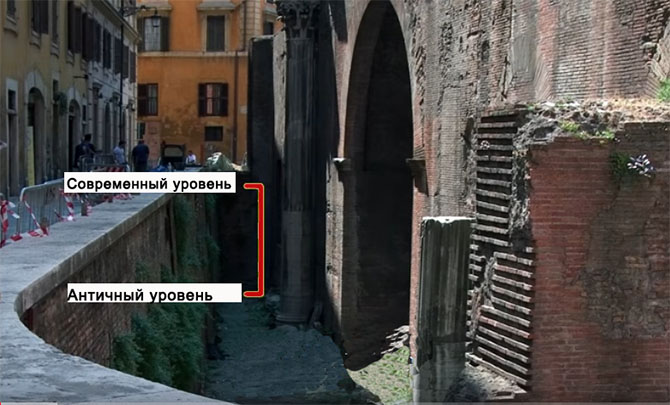
As conceived by the creators, the temple was given a special place among the main city buildings. In terms of plan, the Pantheon is in line with the Champ de Mars, where military exercises took place, and the Mausoleum of Augustus, completed several years earlier. Thus, the special status of the Pantheon in the ideological hierarchy of the Roman Empire was emphasized.
Initially, the Pantheon was a large-scale cult ensemble. The space in front of him was framed by an extended colonnade. She surrounded the Pantheon from all sides and led to the temple. Its imposing dimensions approached closer and closer, and people inevitably seized a sacred awe.
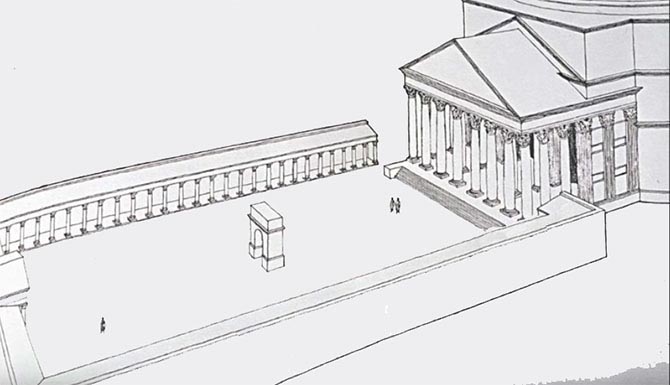
The impression is intensified when we climb the steps of the wide front door and enter the portico, and the bright daylight dims unexpectedly.
The portico of the Pantheon, adjacent to the building of the temple in front of the entrance, is a rectangular covered gallery with 16 Corinthian columns – 8 in front and two rows of 4 on the sides. The entire colonnade stands without supports, solely due to its weight, and carries a huge mass of a triangular pediment.
Each of these columns weighs 60 tons. 2 millennia ago they were taken out of Egypt, which then belonged to the Great Empire. From the quarry where they were cut down, they were dragged over 100 kilometers on wooden sleds to the Nile. Then they waited for the spring flood, when the Nile water rose, loaded onto barges and sent downstream. Then on ships, across the Mediterranean, the columns arrived at the Roman port of Ostia. From there, again on barges, they were taken along the Tiber to Rome. The story of the columns in front of the entrance to the Pantheon alone is amazing! What awaits us inside …
The Pantheon Inside
The entrance to the Pantheon is protected by a giant bronze gate. Entering after the hustle and bustle of the modern Rotunda, you find yourself in unexpected coolness and as if you are entering another dimension. The Pantheon is so amazing that, going inside, you want to hold your breath …
A huge rotunda opens up: a round and at the same time spherical space, and the eye is not able to capture the whole picture at once.
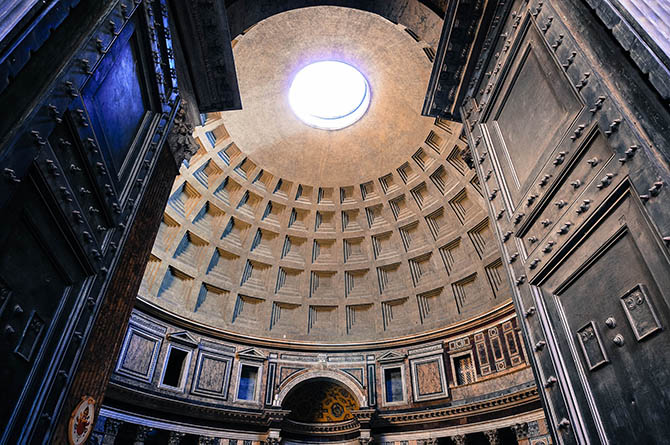
Absolute geometry: the diameter of the Pantheon is equivalent to the distance from floor to dome (43.3 m). An ideal sphere equidistant from its center. From the point of view of the hidden meaning, the sphere is an expression of the universe, the all-encompassing cyclicality, to which the universe is subordinated.
The idea of perfect harmony is also permeated with the magnificent design of walls and floors. Before us is a bright kaleidoscope of simple shapes: rectangles, squares, circles, triangular pediments of false windows of amazing multicolor. Moreover, all this marble splendor has been preserved in its original authenticity, although it is almost 2,000 years old!
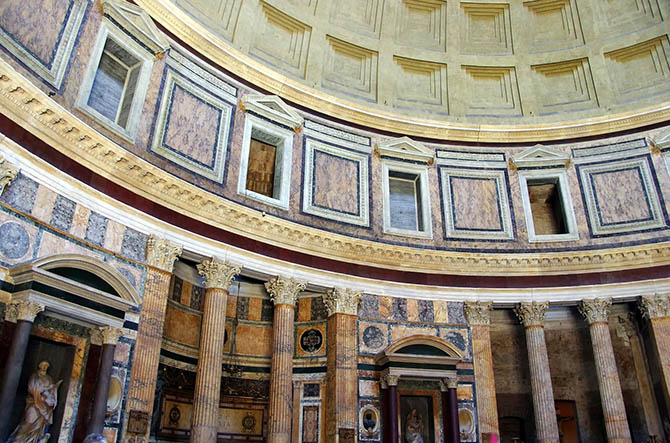
The space of the Pantheon consists of three ascending tiers.
Along the wall of the first, let’s call it “earthly”, there are 28 columns and seven porticos, inside which we see the statues of the gods. They symbolize the main planetary objects of the solar system – the Sun, Moon, Venus, Saturn, Jupiter, Mercury, Mars. Recall that the Pantheon reflects a pagan cult, in which a whole group of gods coexisted, ruling the World.
According to legend, the emperor Hadrian was sitting opposite the entrance to the apse-hollow. He loved the Pantheon and often received his guests here.
The next tier is a series of false windows. This is an intermediate stage between “earthly” and “heavenly”. Blind window openings seem to hint: true Light and true Knowledge are not available in the usual way.
And of course, our eyes go up to the dome …
Dome of the Pantheon
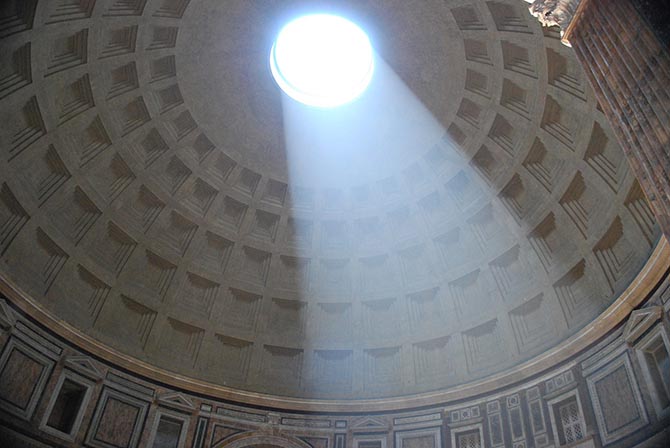
The space is crowned with a huge dome, the embodiment of the celestial sphere. And here, as in the structure of the entire Pantheon, the ancient Romans encrypted the secret meaning. Depression-caissons of the “heavenly” dome are divided into 28 sections, according to the number of columns of “earthly” diameter. 28 is a magic, “perfect” number. The ancients knew only 4 such numbers: 6, 28, 496 and 8128. Pythagoras considered them endowed with a mystical meaning and was convinced that they connect people with the Cosmos. In numerology, “28” means human destiny.
The dome of the Roman Pantheon is a unique creation of ancient Roman architecture. And today it amazes with the accuracy of engineering calculations and the skill of implementation. Incredibly, for 13 centuries the Pantheon remained topped by the largest “floating” dome! It was surpassed only by the Florentine Cathedral Santa Maria del Fiore by architect Filippo Brunelleschi. But the dome of the grandiose Cathedral of St. Peter in the Vatican, designed by the great Michelangelo, has not surpassed.
All the best that was known then to ancient Roman architecture was used in the design and construction of the hemispherical dome of the Pantheon. First of all, the builders used concrete, which was a revolutionary solution for the time. The rounded double walls of the sanctuary were laid out of bricks, and concrete was poured into the pier. This technology provided the required structural rigidity. In engineering terms, it became the key to the phenomenal longevity of the Pantheon.
The walls of the Pantheon are 6 meters thick. Their weight and strength serve as a reliable foundation on which the huge “floating” dome rests, evenly distributing its mass on the walls. To reduce its weight (about 5,000 tons), the builders added scoria, a light volcanic rock, to the concrete.
Oculus, or Eye of the Pantheon
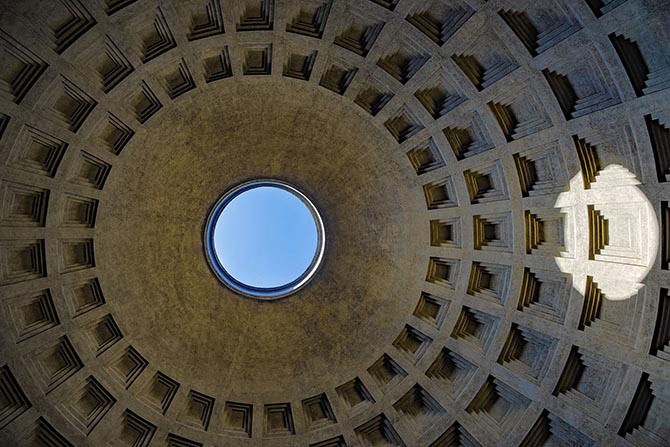
In the center of the dome, we see a wide opening: 7.8 meters in diameter. This is Óculus (lat. oculus, that is, the eye), the only source of light in the Pantheon and the last point of meaning in the multi-valued code of its architecture. The light streaming through the Oculus, alive and constantly changing, falls on the walls and floor of the rotunda. The rays of the celestial body regularly “walk” the walls and floors of the building, mark solar and lunar events, and serve as natural clocks.
 0
0
What is the meaning of Okolus?
According to the worldview of the ancient Romans, in the Pantheon two spheres meet and coexist, two worlds: earthly and heavenly. They represent the microcosm of the Roman world under the endless firmament. At the same time, all things on earth are ruled by god-like emperors, ensuring the correct and unchanging order. But the absolute all-seeing and omnipotent principle rises above the transient rulers. It enters life as light enters through the “Eye of the Pantheon”.
How the pagan Pantheon became a Christian temple
A few centuries later, the Pantheon will turn from a pagan temple into a Christian one, and Rome will become the center of world Christianity. For more than a century, the Pantheon stood closed and abandoned, until at the beginning of the 7th century it found a second life in the form of the Christian Church of the Mother of God “At the Martyrs” (Santa Maria ad Martyres). The temple received this name because the relics of many holy martyrs were transported here from the Roman catacombs.
 1
1According to the medieval manuscript Liber Pontificalis, in the 7th century Pope Boniface IV “asked the Byzantine emperor Phoca for a temple called the Pantheon, and in it he made the church of the eternal Saint Mary and the Martyrs.” It is believed that this happened on May 13, 603. This is how the Pantheon became a shrine for the Christian world, and as a functioning Christian church has survived to this day.
When the temple began a new, Christian life, the Oculus of the Pantheon came in handy, because it expresses Christian ideas about the Almighty God in the best possible way. It is no coincidence that Pantokrator, or Christ the Savior, was depicted in traditional Byzantine churches in the very center of the dome. It is believed that this tradition may be the legacy of the Roman Pantheon.
Read also:
Churches and Cathedrals of Rome
Interesting facts about the Pantheon
 2
2
- Rainwater flowing through the Oculus collects in the center of the marble floor and leaves the temple thanks to the drainage system that the builders also provided. It’s always cool and calm here.
- Every year, June 21, on the day of the summer solstice, visitors can see an amazing visual effect when the sun’s rays shine through the Pantheon: from the Oculus through the massive front door.
- Every year on the day of the Holy Trinity, the marble floor of the Pantheon is covered with a carpet of red rose petals. They are poured through the Oculus, and they, like red butterflies, fall weightlessly on everyone present. This beautiful ritual symbolizes the descent of the Holy Spirit on the apostles.
- A large number of documentaries have been filmed about the Pantheon, one of the symbols of Rome. Several times he participated in the filming of fiction films. The most famous: “Roman Holiday” (1953) and “Angels and Demons” (2009).
In the Heart of Rome audio guide, available in the Travelry app, we share other interesting facts and features of the Pantheon. Explore Rome with inspiration and Travelry!
What to see near the Pantheon
In the middle of the Piazza della Rotonda , is the graceful Fountain of the Piazza Rotunda . It was founded in 1575 by the architect Giacomo della Porta. The water came from the Aqua Virgo aqueduct, completed five years earlier. Over time, grotesque masks and original sculptures of dolphins were added to the sculptural composition. It was a favorite place for merchants, the square was always full. And a fountain with a small reservoir provided everyone with the purest water.
 3
3
At the beginning of the 18th century, the architect Filippo Bariggioni removes the marble bowl of the large fountain and erects a pedestal of lime tuff in its place. It is decorated with the heraldry of the customer – Pope Clement XI: an 8-pointed star over three hills. She, only in bronze, crowns the 6-meter stele of Ramses II, installed on the pedestal of the fountain also at the behest of the Pope.
The granite monument in honor of the Egyptian pharaoh was carved in the 13th century BC. and was part of the temple of the god Ra in Heliopolis. By order of the Emperor Dominian, one of the builders of the Pantheon, the stele was removed in the 100s and erected on the Champ de Mars. Later it was considered lost, and was rediscovered only at the end of the XIV century. She stood on the Capitol for almost 300 years. Since 1711, the stele of the ancient pharaoh has been decorating the fountain of the Rotunda Square.
Read also:
The most beautiful squares and fountains in Rome
Piazza Minerva , which is hidden next to the Pantheon, is always in the shadow of its famous neighbor. But there is something to see. Since the 13th century, there has been an ancient basilica Santa Maria Sopra Minerva – it was built on the site of the ancient temple of Minerva, to which it owes its name. It is considered the only Gothic temple in Rome. And on a cozy square in front of the temple there is an ancient obelisk, erected by the architect Bernini on a pretty sculpture of an elephant.
Literally 5 minutes walk from the Pantheon, the famous Trevi Fountain flaunts – one of the main attractions of Rome, a magnificent architectural composition.
Also nearby, the Sant’Ivo alla Sapienza Church (Chiesa di Sant’Ivo alla Sapienza) “hid” in a small courtyard – one of the brightest examples of Baroque art and the extraordinary, even extravagant architectural style of Borromini.
And in the church San Luigi dei Francesi , built in the 16th century and standing nearby, you can see the famous canvases of the mature Caravaggio.
Of course, these are just some of the striking landmarks in the Pantheon area. Here, in the heart of Rome, they are literally at every step!
See the Travelry app, our mobile travel guide .

